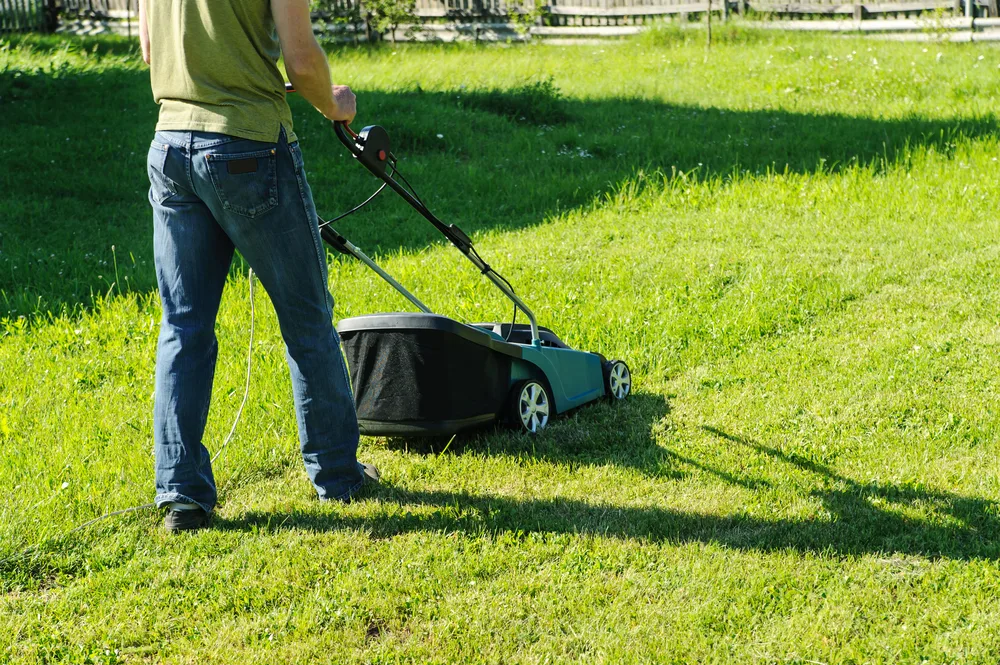While you might feel the urge to mow your lawn whenever you have some free time, it’s important to consider if it’s a good idea to mow wet grass.
Cutting wet grass can lead to issues like browning, fungal diseases, and more. It’s best to wait until your lawn is dry before mowing. If you must mow wet grass, follow these best practices.
Can You Mow Wet Grass?

Mowing wet grass can harm your lawn, mower, and even you. Wet grass can clog your mower, cause fungal diseases, and leave clumps that may harm your lawn.
If you use an electric mower, you risk electric shock. The ideal method is to wait until the grass and soil are dry, usually 2 to 5 hours after a light rain or possibly a full day after heavy rain.
7 Reasons to Avoid Mowing Wet Grass
Here are the main reasons to skip mowing when your grass is wet.
Harder Mowing and Poor Results
Wet grass is slippery and tough to cut, making mowing more difficult. You might tear the grass instead of a clean cut, leading to brown tips.
Mowing on soft, soggy ground can tear up soil and roots, damaging your lawn. Heavy mowers can leave ruts and uneven spots, making your lawn look messy.
Harm to Your Mower
Cutting wet grass causes more wear and tear on your mower. Moisture from the grass and soil can seep into the fuel tank, causing engine issues.
Over time, water can corrode parts of the mower, leading to costly repairs or replacement. Wet clippings can also clog the mower’s blade, causing it to overheat.
Risk of Electric Shock
For those with electric mowers, mowing wet grass can be dangerous. Moisture can lead to electric shock if it contacts damaged cords or wiring. This risk of electrocution is not worth taking.
Slippery Grass Can Cause Injuries
Walking on wet grass can be slippery and lead to falls. Falling near the mower blades or on hard surfaces is especially risky. Rain can also reduce visibility, making it harder to see where you’re going.
Spreading Diseases and Weeds
Wet conditions can spread lawn diseases, such as brown patch disease. Wet clippings on the lawn or mower can also increase the risk of disease.
Wet grass stuck under the mower can spread mold and fungi to your lawn the next time you mow. Mowing wet grass can also spread weeds.
Stains on Shoes and Clothes
While not as serious, mowing wet grass can ruin your clothes with tough stains. Waiting for a dry day can save your outfit from grass stains.
Extra Clean-Up
Mowing wet grass means more clean-up work. Wet grass builds up under the mower and can clog blades. It also sticks to everything, including your clothes and nearby surfaces. To avoid extensive cleaning, wait for dry conditions.
What to Do if You Must Mow Wet Grass
If you must mow after rain, consider hiring a lawn care service. If that’s not an option, follow these tips:
Use a Commercial Mower
Commercial mowers handle wet grass better than home mowers. Their blades and discharge systems are more robust, reducing tearing and clumping.
Avoid Electric Mowers
Do not use electric mowers on wet grass. Battery-powered mowers can also corrode when wet.
Use a Side-Shooter, No Bag
Set your mower to side-discharge without a bag. This will facilitate manual collection later and prevent a mess inside the mower bag.
Sharpen the Blades
Sharp blades make cleaner cuts. You might need to go over the lawn more than once, but sharp blades help.
Set the Mower Higher
Set your mower to the highest setting for a cleaner cut. This means 3 to 4 inches high for most grasses, but check the preferred height for your grass type.
Clean the Mower Underside
Always turn off the mower and disconnect the spark plug before cleaning. Remove wet grass from the tires, underside, and blades to prevent mold and fungi. Clean your shoes and clothes promptly to avoid stains.
Mow Slowly
Go slow when mowing wet grass. Wet blades require more effort, and a slow pace helps ensure an even cut.
Use Fuel Stabilizer
Moisture can affect your mower’s engine. Adding fuel stabilizer to your fuel helps maintain performance. You can find fuel stabilizers at most home improvement stores.
